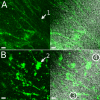Mucociliary interactions and mucus dynamics in ciliated human bronchial epithelial cell cultures
- PMID: 21531774
- PMCID: PMC3154625
- DOI: 10.1152/ajplung.00321.2010
Mucociliary interactions and mucus dynamics in ciliated human bronchial epithelial cell cultures
Abstract
The airway epithelial surface liquid is generally considered to be composed of two layers, a periciliary layer and a continuous thick mucus layer moving in bulk. This view may not be appropriate for all areas of the lung. Our hypothesis, that mucus may form a discontinuous layer with dynamic attachments to the surface, is investigated using a culture system. We used live-cell confocal microscopy to investigate thin mucus layers and fluorescent beads and exogenous MUC5B to visualize mucus dynamics on ciliated human bronchial cultures. A continuous mucus layer was not observed. In sparsely ciliated cultures, mucus attached to ciliated cells; however, in highly ciliated cultures, mucus formed strands several hundred micrometers long. As with increases in ciliation, increases in bead concentration caused the appearance of mucus strands. We confirmed the involvement of mucins in the binding of mucus to cilia by adding labeled purified MUC5B to the cultures. These data suggest that mucins may have an intrinsic ability to form attachments to cilia. The significance of these findings is that aberrant modulation of such an intrinsic property may explain the initiation of highly adherent mucus in cystic fibrosis lung disease.
Figures





Similar articles
-
Equine bronchial epithelial cells differentiate into ciliated and mucus producing cells in vitro.In Vitro Cell Dev Biol Anim. 2010 Feb;46(2):102-6. doi: 10.1007/s11626-009-9258-6. Epub 2009 Nov 14. In Vitro Cell Dev Biol Anim. 2010. PMID: 19915928
-
Influence of silica particles on mucociliary structure and MUC5B expression in airways of C57BL/6 mice.Exp Lung Res. 2020 Sep;46(7):217-225. doi: 10.1080/01902148.2020.1762804. Epub 2020 May 6. Exp Lung Res. 2020. PMID: 32372722
-
BMI-1 extends proliferative potential of human bronchial epithelial cells while retaining their mucociliary differentiation capacity.Am J Physiol Lung Cell Mol Physiol. 2017 Feb 1;312(2):L258-L267. doi: 10.1152/ajplung.00471.2016. Epub 2016 Dec 15. Am J Physiol Lung Cell Mol Physiol. 2017. PMID: 27979861 Free PMC article.
-
Muco-ciliary clearance: A review of modelling techniques.J Biomech. 2020 Jan 23;99:109578. doi: 10.1016/j.jbiomech.2019.109578. Epub 2019 Dec 24. J Biomech. 2020. PMID: 31916998 Review.
-
Role of cilia, mucus, and airway surface liquid in mucociliary dysfunction: lessons from mouse models.J Aerosol Med Pulm Drug Deliv. 2008 Mar;21(1):13-24. doi: 10.1089/jamp.2007.0659. J Aerosol Med Pulm Drug Deliv. 2008. PMID: 18518828 Review.
Cited by
-
Temporal differentiation of bovine airway epithelial cells grown at an air-liquid interface.Sci Rep. 2018 Oct 5;8(1):14893. doi: 10.1038/s41598-018-33180-w. Sci Rep. 2018. PMID: 30291311 Free PMC article.
-
Mucins: the frontline defence of the lung.Biochem Soc Trans. 2018 Oct 19;46(5):1099-1106. doi: 10.1042/BST20170402. Epub 2018 Aug 28. Biochem Soc Trans. 2018. PMID: 30154090 Free PMC article. Review.
-
CFTR, mucins, and mucus obstruction in cystic fibrosis.Cold Spring Harb Perspect Med. 2012 Sep 1;2(9):a009589. doi: 10.1101/cshperspect.a009589. Cold Spring Harb Perspect Med. 2012. PMID: 22951447 Free PMC article. Review.
-
Nanoparticles that do not adhere to mucus provide uniform and long-lasting drug delivery to airways following inhalation.Sci Adv. 2017 Apr 5;3(4):e1601556. doi: 10.1126/sciadv.1601556. eCollection 2017 Apr. Sci Adv. 2017. PMID: 28435870 Free PMC article.
-
Mucociliary Transport in Healthy and Cystic Fibrosis Pig Airways.Ann Am Thorac Soc. 2018 Nov;15(Suppl 3):S171-S176. doi: 10.1513/AnnalsATS.201805-308AW. Ann Am Thorac Soc. 2018. PMID: 30431346 Free PMC article. Review.
References
-
- Armstrong DS, Hook SM, Jamsen KM, Nixon GM, Carzino R, Carlin JB, Robertson CF, Grimwood K. Lower airway inflammation in infants with cystic fibrosis detected by newborn screening. Pediatr Pulmonol 40: 500–510, 2005 - PubMed
-
- Bernacki SH, Nelson AL, Abdullah L, Sheehan JK, Harris A, Davis CW, Randell SH. Mucin gene expression during differentiation of human airway epithelia in vitro. Muc4 and Muc5b are strongly induced. Am J Respir Cell Mol Biol 20: 595–604, 1999 - PubMed
-
- Dillon RH, Fauci LJ, Omoto C, Yang X. Fluid dynamic models of flagellar and ciliary beating. Ann NY Acad Sci 1101: 494–505, 2007 - PubMed
-
- Fulcher ML, Gabriel S, Burns KA, Yankaskas JR, Randell SH. Well-differentiated human airway cultures. Methods Mol Med 107: 183–206, 2005 - PubMed
-
- Gehr P, Green FH, Geiser M, Hof VI, Lee MM, Schürch S. Airway surfactant, a primary defense barrier: mechanical and immunological aspects. J Aerosol Med 9: 163–181, 1996 - PubMed
Publication types
MeSH terms
Substances
Grants and funding
LinkOut - more resources
Full Text Sources
Research Materials

